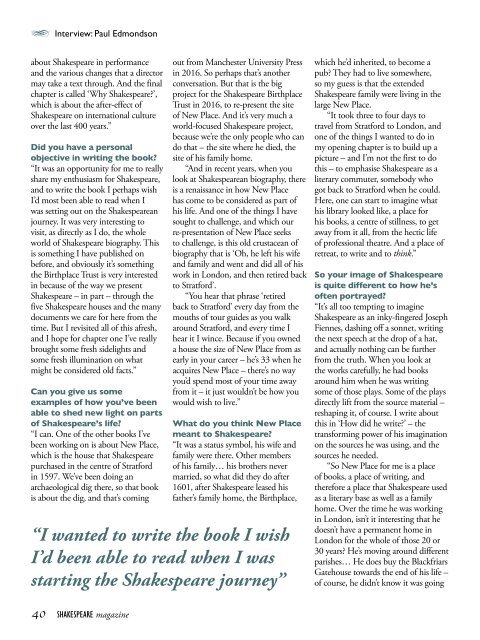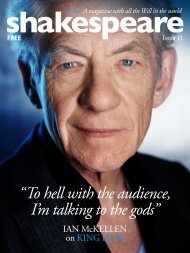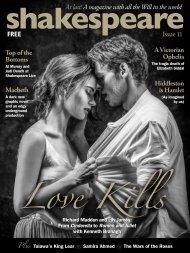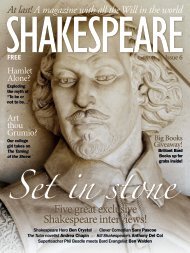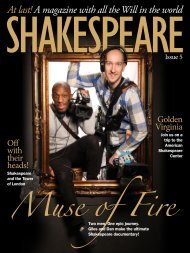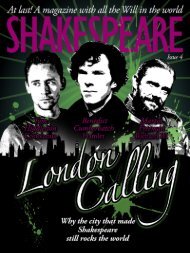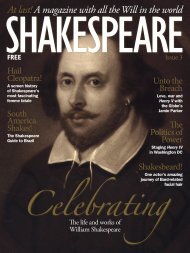Shakespeare Magazine 09
Tom Hiddleston is cover star of Shakespeare Magazine 09! The theme is "Shakespeare at the Cinema" and we review the screenings of both Hiddleston's Coriolanus and Benedict Cumberbatch's Hamlet. We also look at Michael Fassbender and Marion Cotillard's new film of Macbeth, while the Horrible Histories crew chat about their Shakespeare comedy film Bill. Also this issue, we interview James Shapiro, author of 1606: William Shakespeare and the Year of Lear; and Paul Edmondson, author of Shakespeare: Ideas in Profile. There's also a colourful taste of the glorious poster art from new book Presenting Shakespeare. Not forgetting a profile of Tom Hiddleston's Shakespearean career so far.
Tom Hiddleston is cover star of Shakespeare Magazine 09! The theme is "Shakespeare at the Cinema" and we review the screenings of both Hiddleston's Coriolanus and Benedict Cumberbatch's Hamlet. We also look at Michael Fassbender and Marion Cotillard's new film of Macbeth, while the Horrible Histories crew chat about their Shakespeare comedy film Bill. Also this issue, we interview James Shapiro, author of 1606: William Shakespeare and the Year of Lear; and Paul Edmondson, author of Shakespeare: Ideas in Profile. There's also a colourful taste of the glorious poster art from new book Presenting Shakespeare. Not forgetting a profile of Tom Hiddleston's Shakespearean career so far.
You also want an ePaper? Increase the reach of your titles
YUMPU automatically turns print PDFs into web optimized ePapers that Google loves.
Interview: Paul Edmondson<br />
about <strong>Shakespeare</strong> in performance<br />
and the various changes that a director<br />
may take a text through. And the final<br />
chapter is called ‘Why <strong>Shakespeare</strong>?’,<br />
which is about the after-effect of<br />
<strong>Shakespeare</strong> on international culture<br />
over the last 400 years.”<br />
Did you have a personal<br />
<br />
“It was an opportunity for me to really<br />
share my enthusiasm for <strong>Shakespeare</strong>,<br />
and to write the book I perhaps wish<br />
I’d most been able to read when I<br />
was setting out on the <strong>Shakespeare</strong>an<br />
journey. It was very interesting to<br />
visit, as directly as I do, the whole<br />
world of <strong>Shakespeare</strong> biography. This<br />
is something I have published on<br />
before, and obviously it’s something<br />
the Birthplace Trust is very interested<br />
in because of the way we present<br />
<strong>Shakespeare</strong> – in part – through the<br />
five <strong>Shakespeare</strong> houses and the many<br />
documents we care for here from the<br />
time. But I revisited all of this afresh,<br />
and I hope for chapter one I’ve really<br />
brought some fresh sidelights and<br />
some fresh illumination on what<br />
might be considered old facts.”<br />
<br />
examples of how you’ve been<br />
<br />
<br />
“I can. One of the other books I’ve<br />
been working on is about New Place,<br />
which is the house that <strong>Shakespeare</strong><br />
purchased in the centre of Stratford<br />
in 1597. We’ve been doing an<br />
archaeological dig there, so that book<br />
is about the dig, and that’s coming<br />
out from Manchester University Press<br />
in 2016. So perhaps that’s another<br />
conversation. But that is the big<br />
project for the <strong>Shakespeare</strong> Birthplace<br />
Trust in 2016, to re-present the site<br />
of New Place. And it’s very much a<br />
world-focused <strong>Shakespeare</strong> project,<br />
because we’re the only people who can<br />
do that – the site where he died, the<br />
site of his family home.<br />
“And in recent years, when you<br />
look at <strong>Shakespeare</strong>an biography, there<br />
is a renaissance in how New Place<br />
has come to be considered as part of<br />
his life. And one of the things I have<br />
sought to challenge, and which our<br />
re-presentation of New Place seeks<br />
to challenge, is this old crustacean of<br />
biography that is ‘Oh, he left his wife<br />
and family and went and did all of his<br />
work in London, and then retired back<br />
to Stratford’.<br />
“You hear that phrase ‘retired<br />
back to Stratford’ every day from the<br />
mouths of tour guides as you walk<br />
around Stratford, and every time I<br />
hear it I wince. Because if you owned<br />
a house the size of New Place from as<br />
early in your career – he’s 33 when he<br />
acquires New Place – there’s no way<br />
you’d spend most of your time away<br />
from it – it just wouldn’t be how you<br />
would wish to live.”<br />
What do you think New Place<br />
<br />
“It was a status symbol, his wife and<br />
family were there. Other members<br />
of his family… his brothers never<br />
married, so what did they do after<br />
1601, after <strong>Shakespeare</strong> leased his<br />
father’s family home, the Birthplace,<br />
“I wanted to write the book I wish<br />
I’d been able to read when I was<br />
starting the <strong>Shakespeare</strong> journey”<br />
which he’d inherited, to become a<br />
pub? They had to live somewhere,<br />
so my guess is that the extended<br />
<strong>Shakespeare</strong> family were living in the<br />
large New Place.<br />
“It took three to four days to<br />
travel from Stratford to London, and<br />
one of the things I wanted to do in<br />
my opening chapter is to build up a<br />
picture – and I’m not the first to do<br />
this – to emphasise <strong>Shakespeare</strong> as a<br />
literary commuter, somebody who<br />
got back to Stratford when he could.<br />
Here, one can start to imagine what<br />
his library looked like, a place for<br />
his books, a centre of stillness, to get<br />
away from it all, from the hectic life<br />
of professional theatre. And a place of<br />
retreat, to write and to think.”<br />
<br />
is quite different to how he’s<br />
<br />
“It’s all too tempting to imagine<br />
<strong>Shakespeare</strong> as an inky-fingered Joseph<br />
Fiennes, dashing off a sonnet, writing<br />
the next speech at the drop of a hat,<br />
and actually nothing can be further<br />
from the truth. When you look at<br />
the works carefully, he had books<br />
around him when he was writing<br />
some of those plays. Some of the plays<br />
directly lift from the source material –<br />
reshaping it, of course. I write about<br />
this in ‘How did he write?’ – the<br />
transforming power of his imagination<br />
on the sources he was using, and the<br />
sources he needed.<br />
“So New Place for me is a place<br />
of books, a place of writing, and<br />
therefore a place that <strong>Shakespeare</strong> used<br />
as a literary base as well as a family<br />
home. Over the time he was working<br />
in London, isn’t it interesting that he<br />
doesn’t have a permanent home in<br />
London for the whole of those 20 or<br />
30 years? He’s moving around different<br />
parishes… He does buy the Blackfriars<br />
Gatehouse towards the end of his life –<br />
of course, he didn’t know it was going<br />
40 SHAKESPEARE magazine


